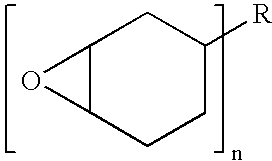Hardener composition for epoxy resins
a technology of hardener composition and epoxy resin, which is applied in the field of hardener composition, can solve the problems of high brittleness of epoxy resin, poor processability of known sma hardener system, and large amount of dust, so as to improve surface appearance, improve the effect of prepreg properties and reduce the amount of dust during handling
- Summary
- Abstract
- Description
- Claims
- Application Information
AI Technical Summary
Benefits of technology
Problems solved by technology
Method used
Image
Examples
example 1
[0103] In this example, an anhydride hardener solution of the present invention was prepared in a 5 L glass reactor, equipped with a mechanical stirrer, a heating jacket, a N2 inlet and a dropping funnel. 1821.3 g of Dowanol* PMA and 40.3 g of SBM 1A17 were charged in the reactor and heated to 90° C. After the solids were completely dissolved, 1554.8 g of SMA 3000 was added to the solution. After the solids were completely dissolved, 201.3 g of Ricon* 131MA10 was added to the solution. Then the solution turned into a white turbid solution but was homogeneous. After 30 minutes, the solution was allowed to cool down to a temperature of 80° C. and MEK was introduced into the solution at 80° C. After complete cooling of the solution to ambient temperature (˜25° C.), the anhydride hardener solution was turbid whitish homogeneous. The hardener solution remained stable during a testing period of 2 months without phase separation nor settling. The theoretical anhydride equivalent weight of ...
example 2
[0105] An anhydride hardener solution was prepared using the same procedure as described in Example 1. The anhydride hardener composition included 1821.3 g of cyclohexanone, 1510.0 g of SMA 3000, 238.7 g of Ricon* 130MA13, 47.7 g of SBM 1A17 and 364.3 g of MEK. The resulting anhydride hardener solution was turbid whitish homogeneous. The hardener solution remained stable during a testing period of 2 months without phase separation nor settling. The theoretical anhydride equivalent weight of the hardener solution was 431 (based on solids).
example 3
[0106] An anhydride hardener solution was prepared using the same procedure as described in Example 1. The anhydride hardener composition included 1821.3 g of cyclohexanone, 1490.6 g of SMA 3000, 254.9 g of Ricon* 131MA10, 51.0 g of SBM 1A17 and 364.3 g of MEK. The anhydride hardener solution was turbid whitish homogeneous. The hardener solution remained stable during a testing period of 2 months without phase separation nor settling. The theoretical anhydride equivalent weight of the hardener solution was 444 (based on solids).
PUM
| Property | Measurement | Unit |
|---|---|---|
| temperature | aaaaa | aaaaa |
| temperature | aaaaa | aaaaa |
| temperature | aaaaa | aaaaa |
Abstract
Description
Claims
Application Information
 Login to View More
Login to View More - R&D
- Intellectual Property
- Life Sciences
- Materials
- Tech Scout
- Unparalleled Data Quality
- Higher Quality Content
- 60% Fewer Hallucinations
Browse by: Latest US Patents, China's latest patents, Technical Efficacy Thesaurus, Application Domain, Technology Topic, Popular Technical Reports.
© 2025 PatSnap. All rights reserved.Legal|Privacy policy|Modern Slavery Act Transparency Statement|Sitemap|About US| Contact US: help@patsnap.com


